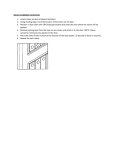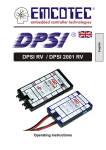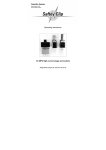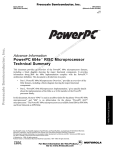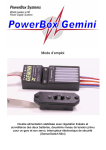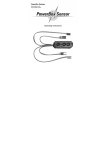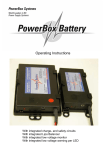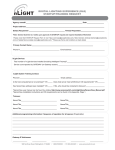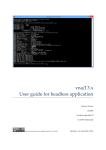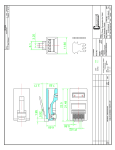Download Operating Instructions Operating Instructions Featuring
Transcript
Operating Instructions Operating Instructions Featuring seven servo-pulse amplifiers plus two independent voltage-controllers POWER BOX 40/24 Competition Dear Customer, we are delighted that you have decided to purchase the PowerBox 40/24 Competition from our range. Your valuable model aircraft can now be fitted with one of the most capable battery backers available, enabling you to couple two batteries and also monitor the voltage of both packs constantly. The unit stores the minimum voltage of both batteries, and you can call up this information after each flight. The PowerBox 40/24 Competition features an integrated two-way signal amplifier for each of seven receiver channels connected to the backer, allowing you to connect up to 4 servos to a single output without problem. This backer also provides a power supply for receiver and servos of 5.9 Volts (+/- 0.1 Volts) with very accurate linear stabilisation. This is generated by an extremely low-loss ICcontrolled regulator (0.12 Volt reduction: very low waste heat). Although this battery backer is simple to operate, you do need to understand certain points if you are to exploit its advantages to the full. Please read through these instructions, and you will quickly feel ‘at home’ with your new accessory. Table of contents 1. 2. 3. 4. 5. 6. Functions of the Dual-Power-Control system........................... Specifications ......................................................................... Connections and Controls....................................................... Information on usage and security .......................................... Sensor Switch......................................................................... Guarantee conditions…………………………………………….…… 1. Functions of the Dual-Power-Control system Page 3 Page 5 Page 5 Page 7 Page 8 Page 10 The backer is intended exclusively for use in modelling, and the sole approved application is in radio-controlled models. It must be powered by a D.C. current source, corresponding to a five-cell NiCd or NiMH battery, or two Lithium-Ion or Lithium-Polymer cells (7.4 Volts). Never connect the unit to a mains PSU! For each of the 7 most important channels of your model aircraft you can connect a maximum of four servos directly to the battery backer, without any problems regarding the servo signal voltage. In each case the signals for the 7 channels are amplified by a two-way amplifier to a level which ensures that the stated number -2 - POWER BOX 40/24 Competition of servos can safely be connected to the receiver via the PowerBox 40/24 Competition even when long cables are in use. A special circuit is employed which de-couples the individual outputs of each servo socket from each other; that is why it is possible to connect up to 4 servos without any one servo affecting the others. When long servo leads are used there is a danger of RF interference signals reaching the receiver by that route, but the integral servo signal amplifiers also effectively prevent this by blocking the interference. For this reason ferrite rings are not required for de-coupling the servo cables when this backer is used. A further important performance feature of the PowerBox 40/24 Competition is its extremely accurate linear stabilisation circuit for the power supply to the receiver(s) and servos. The stabilisation circuit takes the form of two independent voltage regulators, each of which is capable of supplying a current of up to 20 A at a voltage of 5.90 V (accuracy +/- 0.1 V). This means that the unit is the first ever to provide a power supply which fulfils the maximum stated voltage tolerance specified by all RC manufacturers! If you wish to use batteries other than NC or NiMH types, e.g. Lithium-Ion or Lithium-Polymer batteries, the PowerBox 40/24 Competition is the outstanding choice. In fact, the initial idea of voltage stabilisation was developed specifically with these new-technology batteries in mind. We have world-wide experience with our -3 - POWER BOX 40/24 Competition American partner DURALITE, with the result that our design was a unique development, and showed the way forward for other manufacturers. There are absolutely no problems in using your PowerBox 40/24 Competition in conjunction with the lithium battery types mentioned above. We can even alter the voltage display program, so that you can gain the full benefit of the new battery technology. This provides you with the full security provided by the PowerBox 40/24 Competition. Alternatively you can state your intended application when you order your backer, and you will then be supplied with the version for LithiumPolymer batteries. 2. Specification Operating voltage: Power supply: Maximum load: Voltage loss: Voltage stabiliser: No-load current drain: Servo sockets: Temperature range: Dimensions: Weight: Weight, SensorSwitch: 3. 2.5 V to 9 V 2 x 5-cell NiCd or NiMH batteries or 2 x Li-Ion or Li-Polymer cells (7.4 V). 2 x 20 A approx. 0.32 V (total backer function and voltage regulator) 5.9 V +/- 0.1 V for receiver(s) and servos approx. 5 µa (switched off, with SensorSwitch 24 sockets, up to 4 servos -20° C to +75° C 114 x 72 x 19 mm (incl. base plate) 135 g 14 g Connections and controls The two batteries are connected using the pair of high-current sockets located at one end of the backer. Before you connect the two packs it is vital to ensure that they are wired with correct polarity, as the backer is not protected against reversed polarity. If one of the batteries - let alone both - is connected with reversed polarity, the backer will be ruined! We can supply you with ready-made batteries fitted with genuine high-current connectors. If you prefer to make up the connecting leads yourself, you require two of these polarised high-current connectors for the batteries; you will find them in the accessory bag. Please note that the cables must be soldered the right way round: + and - are embossed on the rear face of the connector! Please take great care to observe these markings when soldering the cables, and double-check your work so that there is -4 - POWER BOX 40/24 Competition absolutely no chance of reversed polarity. Take the trouble to produce sound soldered joints, and insulate each of the ‘+’ and ‘-’ joints with a piece of heat-shrink sleeving. baseplate with mounting holes flat cable of the sensor switch sensor to call the minimum voltage memory 24 connetions for servos and 7 receiverchannels intelligent voltage contoller for battery 1 intelligent voltage contoller for battery 2 entrance battery 1 entrance 7 ferrit-rings for battery 2 earth decoupling receiver/power supply All seven servo leads carry the power supply for the receiver(s). Please connect the connectors to the channel sockets of the receiver(s) whose servo signals you wish to amplify; the numbers of the servo lead inputs on the PowerBox 40/24 Competition are identical to the connector block numbers. The integral amplifiers eliminate servo signal damping, distortion and interference, even where cable lengths are in excess of two metres. You should always connect all the servo leads to the receiver even when fewer than seven control channels are connected to the backer, because they all supply current to the receiver. This ensures that the power supply to the receiver(s) is completely reliable. -5 - POWER BOX 40/24 Competition 4. Information on usage and security Naturally it is possible to connect two or - if you wish - even more receivers to this battery backer. If you wish to do this be sure to observe the information supplied by your RC manufacturer concerning the use of two receivers in a model, otherwise there may be problems with inter-action between the two receivers. (The basic rule: make sure that the two receivers are physically separated by a distance of around 20 - 25 cm.) The power supply to the receivers is through the seven servo leads of the PowerBox 40/24 Competition, e.g. three servo sockets to one receiver and four to the other receiver. Select the channels for each receiver whose signals are to be amplified, or which you wish to separate from the receiver for reasons of safety. The ferrite rings in the backer’s connecting leads help to eliminate RF interference carried by long servo leads, but they also de-couple the receiver’s earth from the earth of the backer and all the components connected to it (batteries, servo leads, servos). This ensures that the receiver(s) operate under the conditions for which the RC manufacturer calibrated them (Registered Design No. 202 02 003.7). In practical terms the earth surfaces of a receiver represent the counterbalance, or base point, of the aerial. These standard earth conditions should not be altered by more than a small amount, otherwise the receiver’s optimum tuning may be affected. That is why we have fitted a de-coupling ferrite ring in each of the servo leads to the receiver. This is a relatively complex production procedure, but the effect is that full range is obtained with all standard commercial receivers - and that is certainly worth the trouble. Most RC manufacturers calibrate their receivers using a simulated load of one or two servos connected to the unit, and that is why many professionals have adopted the standard practice of leaving at least one servo connected directly to the receiver at all times. For this reason it is not advisable to connect all receiver channels remotely, i.e. via the backer. This ensures that the receiver works under earth conditions similar to those prevailing when calibrated at the factory. For safety reasons there are two micro-processors at the core of the backer’s circuit, controlling the entire process independently of each other. Both batteries are connected to the two de-coupling diodes via a pair of linear regulators which are also independent of each other. The regulators double as electronic switches. The micro-processors control the two regulators / switches, generating a very accurate supply voltage for servos and receiver(s). The processors also control the LED chains which display battery capacity and minimum values, as well as the external LEDs. -6 - POWER BOX 40/24 Competition 5. Sensor Switch fixing bolt flat-cable for the connection on the PowerBox red LED for signaling activation status SET key for the activation Switching key battery 1 2 green LED´s for signaling switching status Switching key battery 2 fixing bolt The SensorSwitch illustrated here can be attached to the model in any easily accessible location using the two screws supplied. Take care that there is no chance for combustion residues to soil the switch motor. The SensorSwitch does not actually switch the current to the servos and receiver; the switching process is carried out by the two independent electronic switches on the backer, and the SensorSwitch serves only to actuate these switches. The advantage of this arrangement is that the actual switch is inside the model, where it is completely protected from dirt and vibration. Nevertheless, each of the SensorSwitch buttons is fitted with double contacts for secure operation. The single recessed SET button is used to prepare and carry out a switching process: holding the SET button pressed in “arms” the sensor, and the red LED lights up. The two batteries can then be switched on individually using the two remaining buttons marked ‘I’ and ‘II’. Note that the SET button must be held pressed in when -7 - POWER BOX 40/24 Competition you switch them on. The two green LEDs light up to indicate the switched state of the batteries, i.e. the battery is switched on if the green LED lights up. To switch the batteries off, the SET button must again be pressed until the red LED lights up. This prepares the switching process, and “arms” the sensor. The buttons marked ‘I’ and/or ‘II’ can then be pressed to switch the batteries off. The green LEDs go out, and the receiving system is completely switched off. When switched off the system draws an idle current of a mere 5 µA, which corresponds to a fraction of the self-discharge rate of normal batteries. The ribbon cable attached to the SensorSwitch should be connected to the red multi-pin socket on the right-hand side of the backer. Although this connection is secure and firm, it is worth noting that disconnecting the SensorSwitch has no effect on the actual switched state of the device! Nevertheless, it is good practice to deploy the ribbon cable in a location where vibration is low. Don’t let it simply dangle; it is much better to fit some form of strain relief (a small piece of double-sided foam tape between cable and fuselage sometimes works wonders). Our new SensorSwitch system offers you the very highest level of security, as there is absolutely no chance of switching the system off accidentally, nor of compromised reliability due to vibration. The SensorSwitch fulfils yet another task: it is used to display the value of the two minimum voltage memories. This is the procedure: after the landing press both power-on buttons (I and II) simultaneously, whilst holding the ‘SET’ button pressed in. The two LED chains on the backer then display the minimum voltage of both batteries, i.e. the lowest values which occurred during the previous flight. Carrying out this check enables you reliably to detect batteries which are defective, in poor condition, or of inadequate capacity for the model aircraft in question. Since the checks are carried out using the externally mounted SensorSwitch, there is not even any need to open the canopy. The minimum values are reset when both batteries are switched off, i.e. the low voltage recording process restarts for the next flight. The SensorSwitch is available in the colours black or grey, and one or other is very likely to blend inconspicuously with the colour scheme of your model. The inner packing of the SensorSwitch includes a template for the switch aperture, ensuring that it is quick and easy to mount the SensorSwitch accurately on your model. -8 - POWER BOX 40/24 Competition 6. Guarantee conditions During the production process each battery backer undergoes a series of visual and technical tests. We take the maintenance of the highest quality standards very seriously, and this includes bought-in items. That is why we are able to grant a 24 month guarantee on all our battery backer systems, valid from the initial date of purchase. The guarantee covers proven material faults, which will be corrected by us at no charge to you. We wish to emphasise expressly that we reserve the right to replace the unit if a repair is impossible for economic reasons. Proof of the commencement and progress of this guarantee period is the purchase receipt. Repairs which our Service Department carries out for you do not extend the guarantee period. Misuse and maltreatment, such as reversed polarity, excessive voltage, the effects of damp, fuel, external mechanical influences or physical damage invalidate the guarantee. The guarantee does not cover any additional claims, such as consequent damage. Goods must be returned to us post paid; we will not accept C.O.D. shipments. We accept no liability for transit damage or the loss of your shipment. If you need to make a claim under guarantee, send the unit to us at the following address, and be sure to include proof of purchase: PowerBox Systems Modellbau-Deutsch Hindenburgstraße 33 86609 Donauwörth you must include the proof of purchase (receipt) for your backer; the backer must have been operated in accordance with these operating instructions; the backer must have been operated within the voltage and current limits stated in the Specification. -9 - Liability exclusion We are unable to ensure that the battery backer is operated correctly, nor that the entire radio control system has been maintained properly. For this reason we are unable to accept liability for loss, damages or costs which result from the use of the backer, or are connected with its use in any way. Unless otherwise prescribed by binding law, our obligation to pay compensation, regardless of the legal argument employed, is limited to the invoice value of that quantity of our products which was immediately and directly involved in the event which caused the damage. We wish you every success using your new PowerBox 40/24 Competition battery backer, and hope you have loads of fun with it. Donauwoerth, February 2004 PowerBox Systems Modellbau-Deutsch Hindenburgstraße 33 86609 Donauwörth Tel: +49-0906-22559 Fax: +49-0906-22459 [email protected] www.PowerBox-Systems.com











